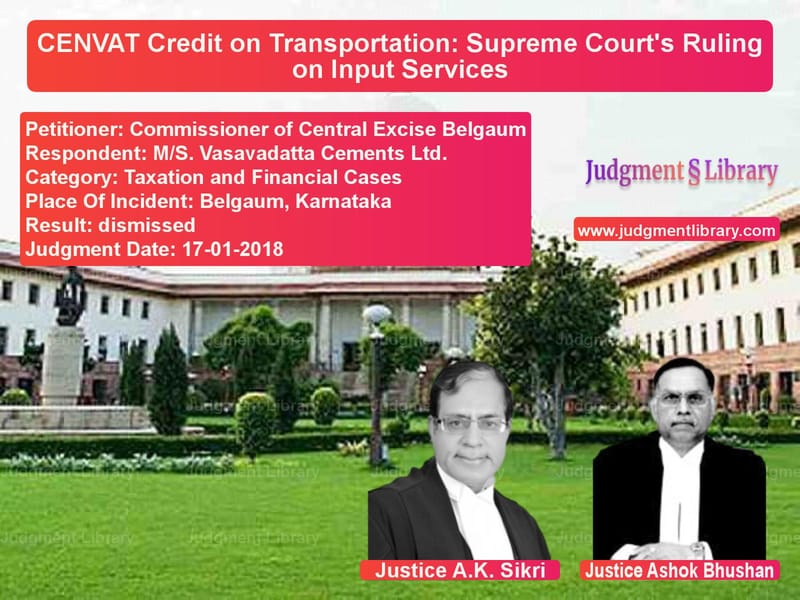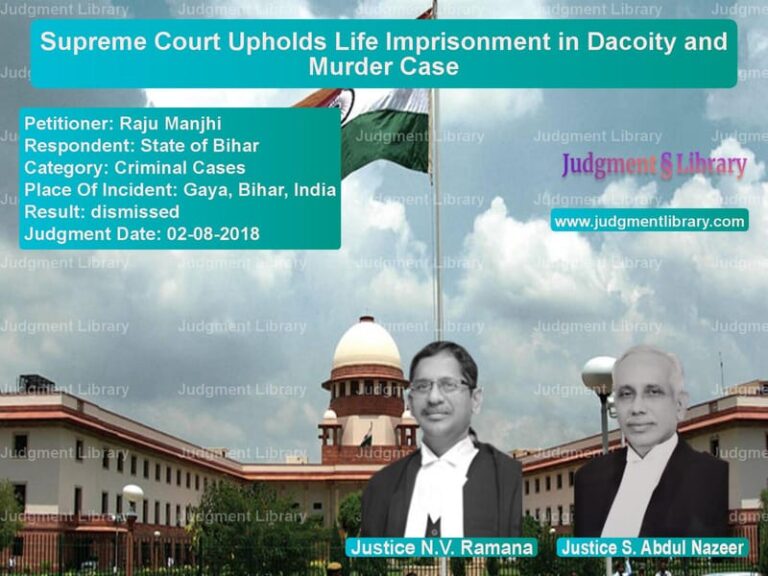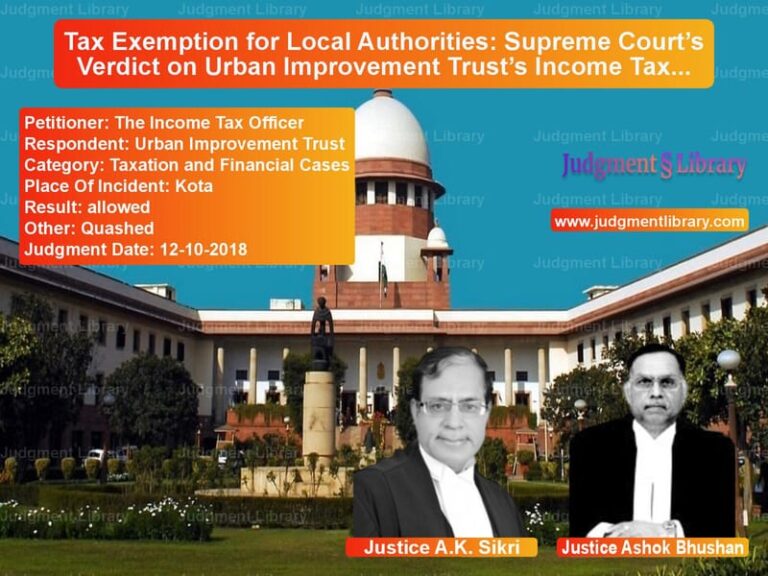CENVAT Credit on Transportation: Supreme Court’s Ruling on Input Services
The Supreme Court of India, in the case of Commissioner of Central Excise Belgaum vs. M/S. Vasavadatta Cements Ltd., addressed a crucial issue regarding the availability of CENVAT credit on Goods Transport Agency (GTA) services for the transportation of goods from the place of removal to depots or customer premises. The ruling clarified the interpretation of ‘input service’ under Rule 2(l) of the CENVAT Credit Rules, 2004, as applicable before the amendment in 2008.
Background of the Case
The case arose when the Central Excise Department challenged the ruling of the Customs, Excise & Service Tax Appellate Tribunal (CESTAT), which had allowed CENVAT credit on transportation services availed by manufacturers beyond the factory premises. The dispute focused on whether such transportation services qualified as ‘input services’ eligible for CENVAT credit under Rule 2(l) of the CENVAT Credit Rules, 2004.
The lead judgment was given in the case of Commissioner of Central Excise & S.T Unit Bangalore vs. M/s. ABB Limited, which was upheld by the Karnataka High Court. The Supreme Court was required to determine whether the interpretation of ‘input service’ adopted by the Tribunal and High Court was correct.
Key Legal Issues
- Did transportation services used for the movement of goods beyond the place of removal qualify as ‘input services’?
- Was CENVAT credit applicable to transportation costs incurred beyond the manufacturing premises?
- Did the amendment in 2008 change the eligibility of such services for CENVAT credit?
Arguments by the Petitioner (Commissioner of Central Excise Belgaum)
The Central Excise Department argued:
- The definition of ‘input service’ in Rule 2(l) only covered services used up to the place of removal.
- The amendment in 2008 clarified the legislative intent that transportation beyond the place of removal was not eligible for CENVAT credit.
- The Tribunal and High Court had misinterpreted the rule, granting undue benefits to manufacturers.
Arguments by the Respondent (M/S. Vasavadatta Cements Ltd.)
The respondents countered these claims by asserting:
- The unamended definition of ‘input service’ included transportation services beyond the factory premises.
- The amendment in 2008 was prospective and did not apply to the period in dispute.
- Tax paid on transportation services for delivering goods to depots or customers should be considered part of the manufacturing process.
Supreme Court’s Observations
The Supreme Court examined the legislative intent and judicial interpretations regarding the definition of ‘input service’. The Court made the following key observations:
- “The definition of ‘input service’ contains both an inclusive and exclusive portion, requiring a balanced interpretation.”
- “Transportation services used from the place of removal to depots or customers were eligible for CENVAT credit before the 2008 amendment.”
- “The amendment in 2008 restricted the availability of credit beyond the place of removal, but such restriction was not applicable for the period before 2008.”
Supreme Court’s Judgment
The Supreme Court ruled in favor of the respondents and upheld the Karnataka High Court’s judgment. The key aspects of the ruling included:
- CENVAT credit was available for transportation services availed for the movement of goods beyond the factory premises before 01.04.2008.
- The amendment in 2008 changed the legal position but could not be applied retrospectively.
- Revenue authorities could not deny credit on the ground that transportation was beyond the ‘place of removal’ before the amendment.
Key Legal Precedents Considered
The Supreme Court referred to important judgments, including:
- Commissioner of Central Excise & S.T Unit Bangalore vs. M/s. ABB Limited (2009): Held that transportation costs beyond the factory premises were eligible for CENVAT credit.
- Collector of Central Excise vs. Dai Ichi Karkaria Ltd. (1999): Explained the principle of input credit as part of the manufacturing process.
- Commissioner of Central Excise vs. Rajasthan Spinning & Weaving Mills Ltd. (2010): Addressed retrospective application of amendments in tax laws.
Implications of the Judgment
The ruling has significant implications for manufacturers and tax authorities:
- Manufacturers can claim CENVAT credit for transportation services availed before 01.04.2008.
- Tax authorities cannot apply the 2008 amendment retrospectively.
- The decision clarifies the interpretation of ‘input service’ for pre-2008 periods, reducing tax disputes.
Conclusion
The Supreme Court’s judgment in Commissioner of Central Excise Belgaum vs. M/S. Vasavadatta Cements Ltd. provides clarity on the applicability of CENVAT credit for transportation services. By reaffirming that transportation services beyond the factory premises were eligible for credit before the 2008 amendment, the ruling ensures consistency in tax administration. This decision strengthens legal certainty in tax matters, benefitting manufacturers and tax authorities alike.
Don’t miss out on the full details! Download the complete judgment in PDF format below and gain valuable insights instantly!
Download Judgment: Commissioner of Cent vs MS. Vasavadatta Cem Supreme Court of India Judgment Dated 17-01-2018.pdf
Direct Downlaod Judgment: Direct downlaod this Judgment
See all petitions in Income Tax Disputes
See all petitions in GST Law
See all petitions in Judgment by A.K. Sikri
See all petitions in Judgment by Ashok Bhushan
See all petitions in dismissed
See all petitions in supreme court of India judgments January 2018
See all petitions in 2018 judgments
See all posts in Taxation and Financial Cases Category
See all allowed petitions in Taxation and Financial Cases Category
See all Dismissed petitions in Taxation and Financial Cases Category
See all partially allowed petitions in Taxation and Financial Cases Category







